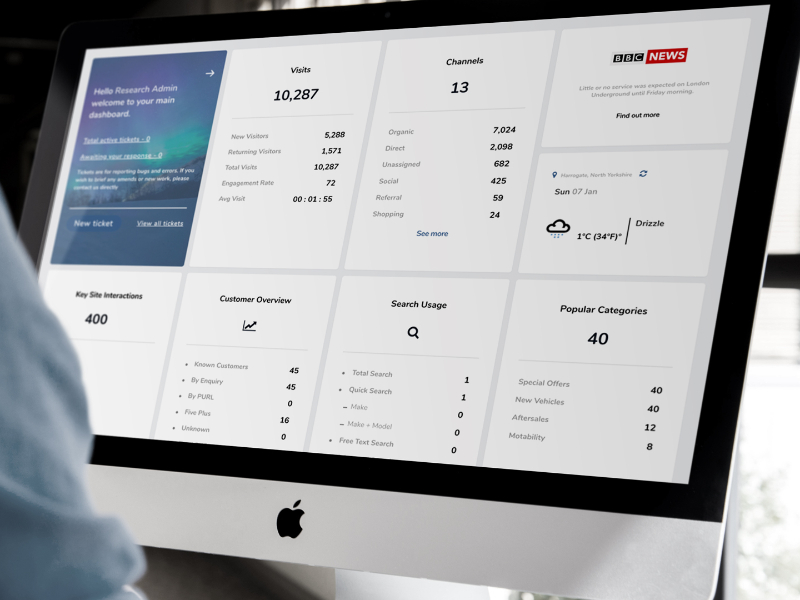
Car dealer websites are complex beasts. They're not just online brochures; they're sophisticated platforms integrating multiple third-party systems, from inventory management and finance calculators to part-exchange valuations and online booking tools. Building or redesigning such a website can be a minefield of decisions, often based on gut feeling and assumptions rather than concrete evidence. But what if there was a better way? What if you could take the guesswork out of web design and make decisions based on cold, hard data? Enter data-led design.
What Does It Mean to be Data-Led?
Being data-led means letting data guide your decisions. It's about understanding how users interact with your website, what they're looking for, and where they're encountering friction. It's about using this data to inform your design choices, ensuring that your website is not only visually appealing but also effective in achieving your business goals.
Why is data important in design? Simply put, data provides insights into user behaviour. It reveals what works and what doesn't, allowing you to optimize your website for maximum impact. Instead of relying on assumptions or personal preferences, you can make informed decisions based on real-world evidence.
What is the difference between data-led and data-driven? While the terms are often used interchangeably, there is a subtle difference. Data-driven design focuses on using data to support design decisions, while data-led design puts data at the forefront of the process. It's a more holistic approach, where data informs every stage of the design process, from initial concept to final execution.
What is a data-led approach? A data-led approach involves collecting and analysing data throughout the design process, using it to validate assumptions, test hypotheses, and make informed decisions. It's an iterative process, where data is continuously gathered and used to refine the design.
What is a data-driven web? A data-driven web is one that is built on a foundation of data. It's a website that is constantly evolving and improving based on user interactions and feedback.
Why is Data-Driven Design Important for Car Dealers?
For car dealerships, data-led design is particularly crucial. With complex websites and diverse user journeys, understanding customer behaviour is paramount. Data can reveal:
- Which pages are most popular (and which are not)?
- Where users are dropping off in the sales funnel.
- How users interact with third-party integrations.
- What devices users are using (desktop, mobile, tablet).
- Which calls to action are most effective.
This information can then be used to inform design decisions, such as:
- Improving website navigation and layout.
- Optimizing content for specific user groups.
- Streamlining the online sales process.
- Enhancing the mobile experience.
- Personalizing content and offers.
How Important is Sample Design to Data Validity?
The quality of your data is crucial for making informed design decisions. This is where sample design comes in. When collecting data, it's important to ensure that your sample is representative of your target audience. This means considering factors like age, location, device type, and browsing behaviour.
A well-designed sample will provide accurate and reliable data, allowing you to make confident decisions about your website design. Conversely, a poorly designed sample can lead to misleading results and ultimately, a website that doesn't meet the needs of your users.
Data-Led Design in Action: A Case Study
Imagine a car dealership struggling with low online conversions. They decide to implement a data-led design approach. By analysing user data, they discover that many users are abandoning the site during the finance application process. Further investigation reveals that the application form is too long and complex, deterring users from completing it.
Armed with this data, the dealership redesigns the application form, making it shorter, simpler, and more user-friendly. They also introduce a progress bar to provide users with a sense of completion. After implementing these changes, they see a significant increase in online conversions.
This is just one example of how data-led design can help car dealerships improve their website performance and achieve their business goals.
Data-Led Decision-Making: The Future of Car Dealer Websites
Data-led decision-making is the future of car dealer websites. By embracing data, dealerships can create websites that are not only visually appealing but also highly effective in attracting, engaging, and converting customers.
Want to learn more about how data-led design can transform your dealership website? Contact The Whole Caboodle today and organise a demo. We'll help you unlock the power of data and create a website that drives results.
Got a question, a brief or a challenge you want to set, feel free to tell us.
Please fill in your details below and let us know when you would like a demonstration of Online Car Events.
Got a question, a brief or a challenge you want to set, feel free to tell us.

